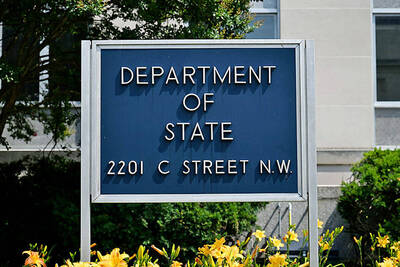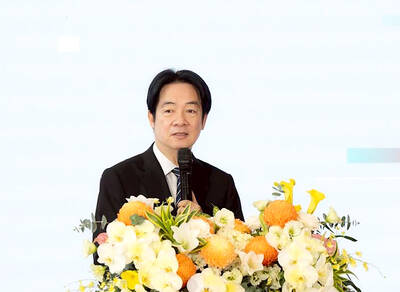China is deploying more surveillance and paramilitary ships to the South China Sea without a clear legal framework to assert its ambiguous territorial claims, risking more confrontations, a report said yesterday.
The bigger patrol ships sent by Chinese maritime surveillance and fisheries agencies have figured in major flare-ups, including an ongoing standoff with a Philippine Coast Guard vessel over a disputed shoal off the western Philippine coast.
At the same time, the nearly dozen Chinese government agencies handling Beijing’s claims compete over budget and power and operate with conflicting mandates and lack of coordination, the International Crisis Group (ICG) said in its report.
Six countries — including Taiwan — are engaged in territorial rifts in the South China Sea, crossed by one of the world’s busiest commercial sea-lanes and accounting for about 10 percent of the annual global fisheries catch.
A map China submitted to the UN in 2009 claims virtually the entire area, but Beijing has so far refused to define the exact extent of its claims, causing confusion and fostering potential conflicts, the ICG said.
Some Chinese ships, according to the ICG, were unaware of the limits of the areas where they were supposed to assert sovereignty.
ICG said it interviewed an official with the Maritime Safety Administration in China’s Hainan Province who said he did not know what area to defend. The official was not further identified.
The China Marine Surveillance, an agency patrolling the South China Sea, plans to increase its personnel from 9,000 to 15,000 and the number of ships from 280 to 520 by 2020, the ICG said. Another agency, the China Fisheries Law Enforcement Command, plans to acquire more helicopter-carrying patrol ships. Such buildup is separate from the strengthening of China’s navy, according to the Brussels-based group.
Manila has asked Beijing to bring their disputes to the UN for arbitration, a process that will require both to delineate their claims. However, Chinese officials have insisted on negotiating with other claimants individually.
The latest confrontation erupted on April 10 when a Filipino warship attempted to arrest Chinese fishermen, who were accused of illegally entering and poaching endangered species at Scarborough Shoal (黃岩島). Two Chinese surveillance ships prevented the arrests and the fishermen slipped away.
Also yesterday, the Philippines warned that China’s sweeping territorial claims in the region may eventually threaten freedom of navigation in the busy region and called on Western and Asian countries to take a stand against any such potential threat.
Philippine Department of Foreign Affairs spokesman Raul Hernandez said China has claimed virtually the entire South China Sea for years. Now, they can aggressively assert its claims as shown by its actions at Scarborough Shoal, he told reporters.
“This is a manifestation of a potential threat to freedom of navigation as well as unimpeded commerce in the area,” he added.
Philippine Secretary of Foreign Affairs Albert del Rosario said that with Beijing claiming almost everything in the South China Sea, “the message is [Beijing] can set the rules for anybody.”
“I think the current standoff is a manifestation of a larger threat to many nations,” Del Rosario told a local TV network in an interview. “They should be concerned if they’re interested in maintaining the freedom of navigation and unimpeded commerce.”

MISINFORMATION: The generated content tends to adopt China’s official stance, such as ‘Taiwan is currently governed by the Chinese central government,’ the NSB said Five China-developed artificial intelligence (AI) language models exhibit cybersecurity risks and content biases, an inspection conducted by the National Security Bureau (NSB) showed. The five AI tools are: DeepSeek, Doubao (豆包), Yiyan (文心一言), Tongyi (通義千問) and Yuanbao (騰訊元寶), the bureau said, advising people to remain vigilant to protect personal data privacy and corporate business secrets. The NSB said it, in accordance with the National Intelligence Services Act (國家情報工作法), has reviewed international cybersecurity reports and intelligence, and coordinated with the Ministry of Justice Investigation Bureau and the National Police Agency’s Criminal Investigation Bureau to conduct an inspection of China-made AI language

BOOST IN CONFIDENCE: The sale sends a clear message of support for Taiwan and dispels rumors that US President Donald Trump ‘sold out’ the nation, an expert said The US government on Thursday announced a possible sale to Taiwan of fighter jet parts, which was estimated to cost about US$330 million, in a move that an expert said “sends a clear message of support for Taiwan” amid fears that Washington might be wavering in its attitude toward Taipei. It was the first announcement of an arms sale to Taiwan since US President Donald Trump returned to the White House earlier this year. The proposed package includes non-standard components, spare and repair parts, consumables and accessories, as well repair and return support for the F-16, C-130 and Indigenous Defense Fighter aircraft,

CHECKING BOUNDARIES: China wants to disrupt solidarity among democracies and test their red lines, but it is instead pushing nations to become more united, an expert said The US Department of State on Friday expressed deep concern over a Chinese public security agency’s investigation into Legislator Puma Shen (沈伯洋) for “secession.” “China’s actions threaten free speech and erode norms that have underpinned the cross-strait ‘status quo’ for decades,” a US Department of State spokesperson said. The Chongqing Municipal Public Security Bureau late last month listed Shen as “wanted” and launched an investigation into alleged “secession-related” criminal activities, including his founding of the Kuma Academy, a civil defense organization that prepares people for an invasion by China. The spokesperson said that the US was “deeply concerned” about the bureau investigating Shen

‘TROUBLEMAKER’: Most countries believe that it is China — rather than Taiwan — that is undermining regional peace and stability with its coercive tactics, the president said China should restrain itself and refrain from being a troublemaker that sabotages peace and stability in the Indo-Pacific region, President William Lai (賴清德) said yesterday. Lai made the remarks after China Coast Guard vessels sailed into disputed waters off the Senkaku Islands — known as the Diaoyutai Islands (釣魚台) in Taiwan — following a remark Japanese Prime Minister Sanae Takaichi made regarding Taiwan. Takaichi during a parliamentary session on Nov. 7 said that a “Taiwan contingency” involving a Chinese naval blockade could qualify as a “survival-threatening situation” for Japan, and trigger Tokyo’s deployment of its military for defense. Asked about the escalating tensions